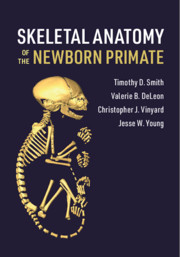Book contents
- Skeletal Anatomy of the Newborn Primate
- Skeletal Anatomy of the Newborn Primate
- Copyright page
- Contents
- Foreword
- Preface
- 1 Introduction
- 2 Primate Development and Growth
- 3 Why Ontogeny Matters
- 4 The Skull
- 5 Dentition
- 6 The Postcranial Axial Skeleton
- 7 The Pectoral Girdle and Forelimb Skeleton
- 8 The Pelvic Girdle and Hindlimb Skeleton
- 9 The Newborn Primate Body Form: Phylogenetic and Life-History Influences
- 10 Ontogeny of Feeding
- 11 Ontogeny of Locomotion
- References
- Index
- Atlas
7 - The Pectoral Girdle and Forelimb Skeleton
Published online by Cambridge University Press: 23 March 2020
- Skeletal Anatomy of the Newborn Primate
- Skeletal Anatomy of the Newborn Primate
- Copyright page
- Contents
- Foreword
- Preface
- 1 Introduction
- 2 Primate Development and Growth
- 3 Why Ontogeny Matters
- 4 The Skull
- 5 Dentition
- 6 The Postcranial Axial Skeleton
- 7 The Pectoral Girdle and Forelimb Skeleton
- 8 The Pelvic Girdle and Hindlimb Skeleton
- 9 The Newborn Primate Body Form: Phylogenetic and Life-History Influences
- 10 Ontogeny of Feeding
- 11 Ontogeny of Locomotion
- References
- Index
- Atlas
Summary
In this chapter we discuss the osteology of the primate forelimb and pectoral girdle from a developmental perspective. The embryonic period of limb development is briefly described. This region in newborn hominoids (apes and humans) is discussed based on the literature and illustrated based on museum specimens. Subsequently, the forelimb skeleton of newborn tarsiers, Old World monkeys, New World monkeys, and strepsirrhines (lemurs and lorises) is described. At birth, the acromion process remains unossified in all primates but the primary center of the corocoid process is ossified in most primates. Haplorrhines generally exhibit better ossified forelimbs (especially at the wrist) than strepsirrhines. Ossification of the forelimb skeleton is most advanced in Old World monkeys and Hylobates compared to all other extant primates except Tarsius. However, ossification rapidly picks up pace postnatally in at least some strepsirrhines (e.g., galagids).
- Type
- Chapter
- Information
- Skeletal Anatomy of the Newborn Primate , pp. 163 - 190Publisher: Cambridge University PressPrint publication year: 2020
- 1
- Cited by



